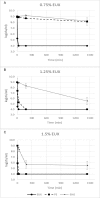Ethylhexylglycerin Impairs Membrane Integrity and Enhances the Lethal Effect of Phenoxyethanol
- PMID: 27783695
- PMCID: PMC5082626
- DOI: 10.1371/journal.pone.0165228
Ethylhexylglycerin Impairs Membrane Integrity and Enhances the Lethal Effect of Phenoxyethanol
Abstract
Preservatives are added to cosmetics to protect the consumers from infections and prevent product spoilage. The concentration of preservatives should be kept as low as possible and this can be achieved by adding potentiating agents. The aim of the study was to investigate the mechanisms behind potentiation of the bactericidal effect of a commonly used preservative, 2-phenoxyethanol (PE), by the potentiating agent ethylhexylglycerin (EHG). Sub-lethal concentrations of EHG (0.075%) and PE (0.675%) in combination led to rapid killing of E. coli (> 5 log reduction of cfu after 30 min), leakage of cellular constituents, disruption of the energy metabolism, morphological deformities of cells and condensation of DNA. Used alone, EHG disrupted the membrane integrity even at low concentrations. In conclusion, sub-lethal concentrations of EHG potentiate the effect of PE through damage of the cell membrane integrity. Thus, adding EHG to PE in a 1:9 ratio has a similar effect on membrane damage and bacterial viability as doubling the concentration of PE. This study provides insight about the mechanism of action of a strong potentiating agent, EHG, which is commonly used in cosmetics together with PE.
Conflict of interest statement
Competing Interests: The authors KS, SLü, KW, and PG-B are employees of Schülke & Mayr GmbH and participated in planning, interpretation of results and the decision to publication. This does not alter our adherence to PLOS ONE policies on sharing data and materials.
Figures






Similar articles
-
Antimicrobial Ingredients as Preservative Booster and Components of Self-Preserving Cosmetic Products.Curr Microbiol. 2019 Jun;76(6):744-754. doi: 10.1007/s00284-018-1492-2. Epub 2018 Apr 12. Curr Microbiol. 2019. PMID: 29651551 Review.
-
The lethal action of 2-phenoxyethanol and its analogues upon Escherichia coli NCTC 5933.Microbios. 1977;19(76):125-41. Microbios. 1977. PMID: 366338
-
Effect of cosmetic chemical preservatives on resident flora isolated from healthy facial skin.J Cosmet Dermatol. 2019 Apr;18(2):652-658. doi: 10.1111/jocd.12822. Epub 2018 Dec 12. J Cosmet Dermatol. 2019. PMID: 30548758
-
Preservative of choice for Prev(e)nar 13™ in a multi-dose formulation.Vaccine. 2011 Sep 22;29(41):7144-53. doi: 10.1016/j.vaccine.2011.05.074. Epub 2011 Jun 7. Vaccine. 2011. PMID: 21651942
-
Self-preserving cosmetics.Int J Cosmet Sci. 2009 Jun;31(3):163-75. doi: 10.1111/j.1468-2494.2009.00492.x. Epub 2009 Mar 19. Int J Cosmet Sci. 2009. PMID: 19302511 Review.
Cited by
-
Polyphenols: Natural Preservatives with Promising Applications in Food, Cosmetics and Pharma Industries; Problems and Toxicity Associated with Synthetic Preservatives; Impact of Misleading Advertisements; Recent Trends in Preservation and Legislation.Materials (Basel). 2023 Jul 3;16(13):4793. doi: 10.3390/ma16134793. Materials (Basel). 2023. PMID: 37445107 Free PMC article. Review.
-
Antimicrobial Ingredients as Preservative Booster and Components of Self-Preserving Cosmetic Products.Curr Microbiol. 2019 Jun;76(6):744-754. doi: 10.1007/s00284-018-1492-2. Epub 2018 Apr 12. Curr Microbiol. 2019. PMID: 29651551 Review.
-
Making a chink in their armor: Current and next-generation antimicrobial strategies against the bacterial cell envelope.Adv Microb Physiol. 2023;83:221-307. doi: 10.1016/bs.ampbs.2023.05.003. Epub 2023 Jun 27. Adv Microb Physiol. 2023. PMID: 37507160 Free PMC article.
-
Synergistic Effects of Propolis Combined with 2-Phenoxyethanol and Antipyretics on the Growth of Staphylococcus aureus.Pharmaceutics. 2021 Feb 4;13(2):215. doi: 10.3390/pharmaceutics13020215. Pharmaceutics. 2021. PMID: 33557393 Free PMC article.
References
-
- Martin M, Winterfeld I, Kramme E, Ewert I, Sedemund-Adib B, Mattner F. Outbreak of Burkholderia cepacia complex caused by contaminated alcohol-free mouthwash. Anaethesist. 2012;61:25–9. - PubMed
-
- Hiom SJ. Preservation of medicines and cosmetics In: Fraise AP, Lambert PA, Maillard JY, editors. Disinfection, Preservation and Sterilization. 4th ed. ed. Oxford, UK: Blackwell Publishing; 2004.
-
- Lundov MD, Opstrup MS, Johansen JD. Methylisothiazolinone contact allergy—growing epidemic. Cont Dermat. 2013;69:271–5. - PubMed
-
- Yazar K, Johnsson S, Lind ML, Boman A, Liden C. Preservatives and fragrances in selected consumer-available cosmetics and detergents. Cont Dermat. 2011;64(5):265–72. - PubMed
MeSH terms
Substances
LinkOut - more resources
Full Text Sources
Other Literature Sources
Molecular Biology Databases

